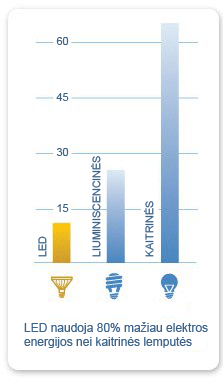What is an LED?
A light-emitting diode is a semiconductor device that converts an electric current directly into light.
Light-emitting diodes are used in many electronic devices as indicator lamps, but recently, their use in lighting has rapidly gained popularity. The main advantages of LEDs compared to incandescent light sources are lower energy consumption, a longer lifespan, higher efficiency, compact size, instant On/Off function, and greater durability and reliability.
How do LEDs work?
To put it simply, LEDs are small light sources that, unlike ordinary incandescent bulbs, don’t have a filament that will burn out. Just a few millimetres long, the diode emits light when a current flows through it.
An LED consists of several semiconductor layers, where light is generated in its active layer.
Why choose LED lighting?
The main reasons why you should choose LED lighting are:
-
-
Lower energy consumption
Light-emitting diodes use 50-80% less electricity than conventional light bulbs. The power of the LED bulbs that are currently available ranges from 1W to 7W.
-
Longer lifespan
-
LED light sources will last from 30,000 to 50,000 hours. Meanwhile, incandescent light bulbs last an average of 1,000 hours, while compact fluorescent lamps last about 8,000 hours.
If used on average of 5 hours a day, LED lamps have a lifespan of 15 to 25 years.
-
Higher efficiency
The future of lighting lies with more efficient products that consume less electricity. LED lamps produce about 70-90 lumens from 1W, while conventional incandescent bulbs only produce about 15 lumens of light output.
Unlike fluorescent or incandescent light bulbs, light emitting diodes can convert electricity into light with almost no loss, so the diodes hardly heat up at all.
Unlike fluorescent or incandescent light bulbs, light emitting diodes can convert electricity into light with almost no loss, so the diodes hardly heat up at all.
-
Compact size
Small, compact LED size allows manufacturers to create lights of various designs and shapes. They usually take up less space and are easy to install.
-
Frequent On/Off
Frequent switching on/off damages fluorescent and gas discharge lamps – their service life is shorter and the lamps take longer to turn on.
In this respect, LED light bulbs are an ideal option when frequent switching on and off is required. In addition, LEDs turn on very quickly – in just a few microseconds – and the possibility of burnout is minimal.
In this respect, LED light bulbs are an ideal option when frequent switching on and off is required. In addition, LEDs turn on very quickly – in just a few microseconds – and the possibility of burnout is minimal.
-
Durability and reliability
LED lamps have a completely different structure than traditional lamps. The LED chips are coated with an adhesive that protects them from moisture and other factors in the external environment. They also have no moving parts or glass, which makes them strong and impact-resistant.
Light-emitting diodes are made of non-toxic materials, and can be recycled and reused. Meanwhile, fluorescent lamps contain mercury, which is very harmful to human health and pollutes the environment.
Light-emitting diodes are made of non-toxic materials, and can be recycled and reused. Meanwhile, fluorescent lamps contain mercury, which is very harmful to human health and pollutes the environment.






